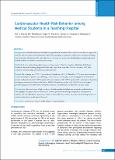Please use this identifier to cite or link to this item:
https://hdl.handle.net/20.500.14356/1937Full metadata record
| DC Field | Value | Language |
|---|---|---|
| dc.contributor.author | Giri, S | - |
| dc.contributor.author | Sharma, S R | - |
| dc.contributor.author | Timalsina, S | - |
| dc.contributor.author | Yadav, V | - |
| dc.contributor.author | Koirala, S | - |
| dc.contributor.author | Koirala, A | - |
| dc.contributor.author | Neupane, S | - |
| dc.contributor.author | Neupane, M | - |
| dc.date.accessioned | 2023-06-02T05:24:34Z | - |
| dc.date.available | 2023-06-02T05:24:34Z | - |
| dc.date.issued | 2012 | - |
| dc.identifier.citation | GiriS., SharmaS. R., TimalsinaS., YadavV., KoiralaS., KumarA., NeupaneS., & NeupaneM. (2013). Cardiovascular Health Risk Behavior among Medical Students in a Teaching Hospital. Journal of Nepal Health Research Council. https://doi.org/10.33314/jnhrc.v0i0.329 | en_US |
| dc.identifier.issn | Print ISSN: 1727-5482; Online ISSN: 1999-6217 | - |
| dc.identifier.uri | http://103.69.126.140:8080/handle/20.500.14356/1937 | - |
| dc.description | Original Article | en_US |
| dc.description.abstract | Abstract Background: Medical students are the health care providers of tomorrow. The health behaviors that are acquired in early life and in medical school will influence their future acceptance and practice of preventive strategies including their interaction with patients. The main objective of our study was to assess the health behavior and perceptions of medical students in relation to cardiovascular diseases. Methods: A cross sectional descriptive study was done among 159 medical students of Institute of Medicine, Tribhuvan University Teaching Hospital in Kathmandu, Nepal from September 2010 to December 2010. Data collection was done using a self administered questionnaire. Results: The mean age was 22.9±2.5 yrs and a male: female ratio of 2.1:1. Thirty Five (22%) were current smokers, 56 (35%) indulged in episodic heavy drinking, 25 (15.7%) were overweight, 34 (21%) engaged in recommended amount of physical activitiy,58 (33%) regulated fat consumption and 46 (28%) regulated salt consumption. Regarding developing cardiovascular disease in the future, 85(53%) showed concern but only 33 (38%) of these adopted preventive practices. 101 (64%) believed that their medical school life had a harmful effect on their health. Conclusions: Our study shows a high prevalence of cardiovascular risk behaviours among the medical students. This highlights the urgency that we must take to promote preventive knowledge and practices among medical students. This will help them to become prevention oriented clinicians in future to counter the increasing burden of cardiovascular diseases in this part of the world. Keywords: cardiovascular diseases; health behavior; medical students. | en_US |
| dc.language.iso | en | en_US |
| dc.publisher | Nepal Health Research Council | en_US |
| dc.relation.ispartofseries | Sep-Dec, 2012;329 | - |
| dc.subject | Cardiovascular diseases | en_US |
| dc.subject | Health behavior | en_US |
| dc.subject | Medical students | en_US |
| dc.title | Cardiovascular Health Risk Behavior among Medical Students in a Teaching Hospital | en_US |
| dc.type | Journal Article | en_US |
| local.journal.category | Original Article | - |
| Appears in Collections: | Vol. 10 No. 3 Issue 22 Sep - Dec, 2012 | |
Files in This Item:
| File | Description | Size | Format | |
|---|---|---|---|---|
| 329-Article Text-328-1-10-20130823.pdf | Fulltext Download | 195.7 kB | Adobe PDF |  View/Open |
Items in DSpace are protected by copyright, with all rights reserved, unless otherwise indicated.
